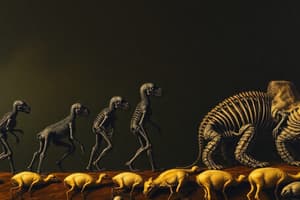Podcast
Questions and Answers
What are the blueprints for the development and characteristics of an organism?
What are the blueprints for the development and characteristics of an organism?
- Chromosomes
- Genes (correct)
- Cells
- Proteins
Which of the following describes the process by which organisms with advantageous traits are more likely to survive and reproduce, leading to an increase in the frequency of these traits in a population?
Which of the following describes the process by which organisms with advantageous traits are more likely to survive and reproduce, leading to an increase in the frequency of these traits in a population?
- Evolution
- Natural Selection (correct)
- Adaptation
- Mutation
What is the term used to describe the gradual changes in organisms over time, leading to the emergence of new species?
What is the term used to describe the gradual changes in organisms over time, leading to the emergence of new species?
- Natural Selection
- Mutation
- Evolution (correct)
- Adaptation
Which of the following is NOT a key element of the concept of Descent with Modification?
Which of the following is NOT a key element of the concept of Descent with Modification?
The concept of 'Descent with Modification' emphasizes that:
The concept of 'Descent with Modification' emphasizes that:
How does Darwin's concept of 'Descent with Modification' explain the diversity of life on Earth?
How does Darwin's concept of 'Descent with Modification' explain the diversity of life on Earth?
What is the significance of the concept of 'Descent with Modification' in understanding biological evolution?
What is the significance of the concept of 'Descent with Modification' in understanding biological evolution?
What is NOT a key component of 'Descent with Modification'?
What is NOT a key component of 'Descent with Modification'?
Flashcards
Descent with modification
Descent with modification
The process of passing traits from parent organisms to offspring, leading to organismal diversity.
Heredity
Heredity
The passing on of traits from parent to offspring, controlled by genes.
Gene
Gene
The basic unit of heredity that contains information for making an organism.
Natural Selection
Natural Selection
Signup and view all the flashcards
Evolution
Evolution
Signup and view all the flashcards
Common Ancestor
Common Ancestor
Signup and view all the flashcards
Organismal Diversity
Organismal Diversity
Signup and view all the flashcards
Traits
Traits
Signup and view all the flashcards
Study Notes
Descent with Modification and Evolutionary Thoughts
- Descent with modification is the passing of traits from parent organisms to their offspring.
- Heredity is the passing of traits, and the basic unit of heredity is the gene.
- Genes act as blueprints for organisms, holding information about their growth, development, behavior, appearance, and physiology.
- Evolution, as described by Charles Darwin, is "descent with modification."
- This refers to species changing over time, leading to new species sharing a common ancestor.
Objectives of the Lesson
- Students will be able to discuss the patterns of descent with modification, showing how common ancestors produce observed organismal diversity.
- Students will be able to trace the development of evolutionary thought.
- Students will appreciate the importance of Descent with modification by explaining the given example.
Explanation of Descent with Modification
- Heredity: Traits are passed from parents to offspring, controlled by genes.
- Natural Selection: Organisms with traits that help them survive and reproduce are more likely to pass on those traits to their offspring. Variations arise and some variations will make survival/reproduction more likely.
- Evolution: The process by which new species develop from existing species over time.
Stages of Human Evolution
- Australopithecus afarensis: An early human ancestor.
- Homo habilis: A human ancestor known for tool use.
- Homo erectus: An ancestor with upright posture.
- Homo neanderthalensis: Early form of humans with a distinct structure.
- Homo sapiens: Modern humans.
Characteristics of Human Evolution
- Human skulls were smaller than those of modern humans.
- Brain volume was between 600-700 cubic centimeters.
- Humans had higher brow ridges than chimpanzees.
- Faces had more pronounced facial structures.
- Foreheads had distinct edges.
- Occipital condyles were positioned ventrally.
- Skull backs were round shaped.
Studying That Suits You
Use AI to generate personalized quizzes and flashcards to suit your learning preferences.




